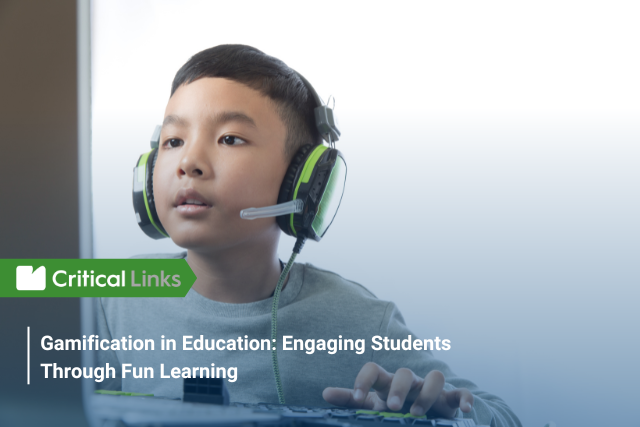
Gamification in Education: Engaging Students Through Fun Learning
In today’s rapidly evolving educational landscape, educators face the ongoing challenge of keeping students motivated and focused during class. Traditional teaching methods often struggle to capture students’ attention and maintain their engagement over time. However, a promising solution has emerged in the form of gamification – the integration of game elements into educational activities to enhance learning outcomes and student participation. Gamification represents a paradigm shift in the way we approach education. By leveraging the inherent appeal of games, educators can transform lessons into dynamic and interactive experiences that captivate students’ interest and foster a deeper engagement with the subject matter. From elementary schools to universities, gamification has been increasingly embraced as a powerful tool for creating more stimulating and effective learning environments.
Below you can find some of the key benefits:
Increased Motivation
Conventional approaches sometimes lead to decreased motivation among students. They may find traditional learning methods monotonous or lack the immediate feedback that helps them gauge their progress. Gamification addresses this concern by incorporating elements such as achievements, badges, and leaderboards. These features provide students with immediate recognition for their accomplishments, fostering a sense of achievement and progress.
Enhanced Engagement
Games are designed to captivate audiences, and gamification strategically leverages this quality to make educational content more engaging. By transforming the learning process into an enjoyable game, students are more likely to maintain focus and sustained interest in the material. Whether it involves solving mathematical problems, mastering a new language, or exploring historical events through interactive quests, gamified learning experiences provide students with a sense of agency and ownership over their learning journey. This increased engagement not only makes learning more enjoyable but also facilitates deeper comprehension and retention.
Promoting Collaboration
Many educational games involve elements of teamwork and competition, encouraging students to work together towards common goals. By creating opportunities for peer-to-peer learning and interaction, gamification fosters a sense of camaraderie and mutual support among students. Whether they are collaborating on solving complex problems, brainstorming ideas, or sharing resources, gamified learning environments provide students with valuable opportunities to develop teamwork and communication skills. This collaborative approach not only enhances the overall learning experience but also prepares students for success in future academic and professional endeavors.
Customized Learning Paths
Gamification facilitates customized learning experiences by dynamically adjusting to the individual progress of each student. Educational games can be meticulously crafted to modulate difficulty levels in accordance with a student’s proficiency, ensuring that each learner is adequately challenged. This personalized approach accommodates diverse learning styles and paces, allowing students to learn at their own pace and according to their individual needs. By providing tailored learning experiences, gamification promotes a more inclusive and equitable learning environment where every student has the opportunity to succeed.
Real-world Application
One of the unique aspects of gamification is its ability to bridge the gap between theory and practice by simulating real-world scenarios and applications. Through simulations, role-playing, and scenario-based games, students can apply their knowledge and skills in practical contexts, reinforcing their understanding and preparing them for real-world challenges. By engaging in hands-on, experiential learning activities, students gain valuable insights into how their learning can be applied in real-life situations. This application-oriented approach not only enhances students’ understanding of the material but also equips them with the skills and competencies needed to succeed in their future academic and professional pursuits.
Gamification in education offers immense potential by captivating and motivating students, improving memory retention, encouraging collaboration, tailoring learning experiences, and connecting theoretical knowledge with real-world applications. As educators seek out innovative teaching methods, gamification emerges as a promising strategy for cultivating dynamic, engaging, and productive learning atmospheres. Leveraging the captivating nature of games, educators can empower students to take charge of their learning, unlocking their capabilities and equipping them for success in a constantly evolving society.
Despite the numerous benefits of integrating gamification into classrooms, this avenue for teaching is still not widely adopted in many schools due to limitations related to infrastructure or connectivity. However, it is important to highlight that there are alternatives available in the market that enable the use of interactive games and simulations even in such circumstances. This is where solutions like the C3 Micro-Cloud come into play, providing an accessible and effective way to bring the benefits of gamification to classrooms with internet issues. One of the main advantages of the C3 Micro-Cloud is its ability to operate without relying on a constant internet connection. This means that both teachers and students can use educational applications, games, and interactive simulations even in areas where connectivity is limited or inconsistent. The C3 Micro-Cloud also allows educators to customize educational content according to the specific needs of their students. They can select and provide a wide variety of apps, games, and educational resources, tailoring teaching to meet the different skills and learning styles of each student. Schools can implement, configure, and manage the C3 Micro-Cloud with ease, even if they do not have advanced technical knowledge. By investing in solutions like the C3 Micro-Cloud, schools can ensure that all students have access to quality education, preparing them for a successful future.
